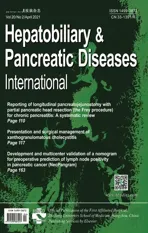Practice of precision surgery in primary liver cancer
2021-05-19YunHuZhenHuShen
Yun Hu ,Zhen-Hu Shen
a Department of Pathology, Huzhou Traditional Chinese Medicine Hospital Affiliated to Zhejiang Chinese Medical University, Huzhou 3130 0 0, China
b Department of General Surgery, Huzhou Central Hospital, Huzhou 313003, China
Primary liver cancer (PLC) is mainly composed of three major cancer:intrahepatic cholangiocarcinoma,hepatocellular carcinoma and mixed hepatocellular-cholangiocellular carcinoma.PLC is the sixth most common cancer and the second most common cause of cancer-related death worldwide [1].Although scientists tried hard to explore the mechanisms and treatments,patients with PLC have poor prognoses and the treatments remain challenging [2],and surgical resection or liver transplantation is the only treatment for long-term survival.
The features of the anatomical complexity and diverse physiological function make the liver surgery sophisticated.Currently,with the advancement of modern surgical instruments and technologies,the concept of precision surgery is widely accepted.Precision surgery in PLC was proposed in 2009 by Dong and Huang [3].As a newly introduced surgical concept and technical system,precision surgery involves precise practices to ensure the best outcome for the individual patient with multi-objective optimization of therapeutic effectiveness,sur gical saf ety,and minimal invasiveness [4].This concept represents a new surgical paradigm that mainly includes preoperative evaluation,surgical planning,surgical technique and perioperative management.It is not a simple surgical methodology,but an entire operation-centered surgical practice.Its proposal makes surgery of PLC more precise,safe and standardized.
The precise preoperative evaluation and meticulous surgical planning are the premise for precision surgery to ensure safety and obtain optimal outcomes.Liver resection of PLC is still burdened by high mortality and some lethal postoperative complications,especially postoperative liver failure,and preoperative evaluation is still a challenge [5].Traditionally,the preoperative evaluation and the surgical planning are based on surgeon’s experience and Child-Pugh score.Sometimes,it is not precise enough,especially for complicated cases.Precision surgery advocates more accurate preoperative evaluation with modern techniques and target of surgical interventions in patients in whom the benefit is likely to outweigh the risk.Recently,a series of new preoperative evaluation techniques including ultrasound elastography and indocyanine green retention test are helpful for precision surgical planning.Nowadays,liver imaging has been routinely applied in meticulous surgical planning of PLC,and emerging relevant techniques represented by three-dimensional visualization further accelerate its application.Optimal surgical planning which is needed to maintain a balance between the requirement for an acceptable resection margin and the preservation of a functional remnant liver volume can be validated with the help of three-dimensional visualization and printing technique.Through the use of the threedimensional visualization system,the remnant of liver volume and the relationships between tumor and crucial blood vessels can be demonstrated intuitively [6].The final planning is decided through multidisciplinary discussion to exclude individual bias.
Precise surgical operation and excellent perioperative management are the soul of precision surgery in PLC.Surgeons often design the surgical plane rely on the marks of liver surface and carry it out based on their educated guesswork.This method cannot be satisfied for the concept of radical PLC resection and sometimes leads to complications [7].Precision liver surgery focuses on technical system to remove the tumor completely,reduce intraoperative bleeding and injury,and preserve maximum liver function,and it is an essential treatment tool for malignant tumors of the liver.Various approaches have been advocated and combined in operation for more precision and less invasion mainly including intraoperative navigation technology,precise liver vascular occlusion technology,laparoscopic or robotic technology and precise anesthesia technology.Furthermore,a variety of instruments have been designed to allow for precise identification and control of intrahepatic vascular and biliary structures,and these instruments include Cavitron Ultrasonic Surgical Aspirator,harmonic scalpel,radiofrequency coagulation device and so on.Precise perioperative management incorporates the concepts of fast recovery but is more precise.It mainly includes goal-oriented fluid management,multimodal precise analgesia,precise activity and nutrition support to ensure maximized and fast recovery for each patient.
In our center,two important aspects should be kept in mind when performing precision surgery for PLC:detailed surgical planning and precision surgical navigation.Three-dimensional simulation of liver resection has been utilized to predict remnant liver volume and to determine the accurate surgical plane,and indocyanine green target portal staining and intraoperative ultrasound were applied for clearer demarcation and real-time navigation of parenchymal dissection.However,other aspects of the precision surgery in PLC also play important roles.Our experiences of precision surgery application in PLC are summarized in Fig.1 .

Fig.1.Precision surgery in clinical practice of primary liver cancer patients.It consists of preoperative evaluation,surgical planning,surgical technique and perioperative management.Each includes a series of surgical practices and theories.The primary purpose of precision surgery is to make the surgery of primary liver cancer more precise,safe and standardized.
As a consequence of rising technological revolution,the concept of precision surgery plays an important role in promoting the finest clinical practice in PLC to meet the increasing demand for healthcare in this contemporary society.It will continue and prevail with the assistance of technological revolution.We believe that the precision surgery will be more common in liver surgery and various surgical fields.
Acknowledgments
None.
Credit authorship contribution statement
Yun Hu:Data curation,Investigation,Writing -original draft.Zhen-Hua Shen:Conceptualization,Funding acquisition,Project administration,Writing -review &editing.
Funding
This study was supported by a grant from the Natural Science Foundation of Zhejiang Province (LGF19H030 0 03).
Ethical approval
Not needed.
Competing interest
No benefits in any form have been received or will be received from a commercial party related directly or indirectly to the subject of this article.
杂志排行
Hepatobiliary & Pancreatic Diseases International的其它文章
- Reporting of longitudinal pancreatojejunostomy with partial pancreatic head resection (the Frey procedure) for chronic pancreatitis:A systematic review
- Hepatobiliary&Pancreatic Diseases International
- Presentation and surgical management of xanthogranulomatous cholecystitis
- Transjugular intrahepatic portosystemic shunt is effective in patients with chronic portal vein thrombosis and variceal bleeding
- Long-term follow-up of HCV patients with sustained virological response after treatment with pegylated interferon plus ribavirin
- Laparoscopic hepatectomy is superior to open procedures for hepatic hemangioma
